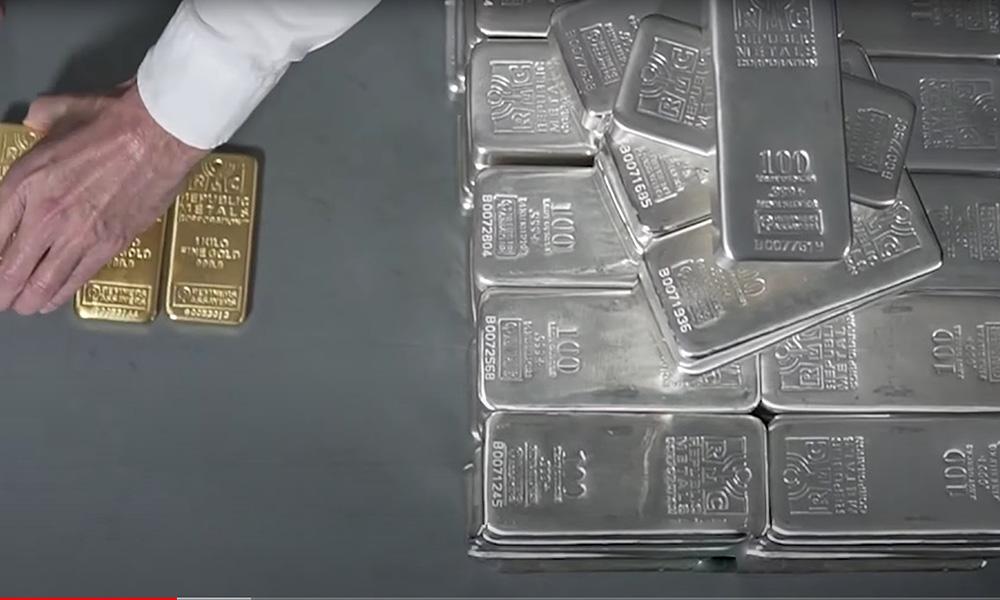Counterintuitive warning! A massive inversion between futures and spot prices: Why are silver bulls still stuck?
2025-10-24 19:57:14
Gottlieb revealed that in the past two weeks alone, 29 million ounces of silver were physically withdrawn from COMEX warehouses in New York. He also issued a stark warning about the lack of transparency in the platinum market, saying the situation there could be even more serious.
On the eve of this large-scale outflow of physical silver, the market had just experienced a turbulent week: on Tuesday, the price of gold plummeted nearly 5.5% from a high above $4,360, fell to a low near $4,120, and then gradually rebounded; on the same day, silver fell even more, by 7.5%.

Silver physical supply under pressure
The pressure on the physical silver market is the most prominent, with the core contradiction concentrated in the sharp reversal of capital flows between the two major global trading hubs: the New York Mercantile Exchange (COMEX), the main US futures exchange, and the London market, the world's largest physical trading center.
Gottlieb explained that a "perfect storm" of demand factors has led to the depletion of free-floating silver stocks in London vaults (hereinafter referred to as "free float stocks"). "Free float stocks (in London) have fallen from 305 million ounces to approximately 125 million ounces... This has directly contributed to the current tightness across the market," he said.
The gap in the London market has now triggered a sharp reversal of capital flows, with London spot silver trading at a premium, prompting banks to withdraw physical silver from the COMEX and ship it across the Atlantic back to London, a highly profitable operation.
"We've gone from 530 million ounces (COMEX silver inventories) to about 501 million ounces today, meaning about 29 million ounces of silver have been shipped out of the United States," Gottlieb said. This trend is also confirmed by the CME Group's daily warehouse report, which shows a continuous decline in silver inventories since October.
Gottlieb used a startling figure to illustrate the scale of the supply gap: "In my judgment, London needs an additional 100 million to 150 million ounces of physical silver to return the market to normal."
This gap in the London market has now triggered a sharp reversal of capital flows. London spot silver is trading at a premium, prompting banks to withdraw physical silver from the COMEX and ship it across the Atlantic back to London, a highly profitable operation. "We've gone from 530 million ounces (of silver) on the COMEX to about 501 million ounces today, meaning about 29 million ounces have been shipped out of the US," Gottlieb revealed. This trend is also confirmed by the CME Group's daily warehouse report, which shows a continuous decline in silver inventories since October.
Gottlieb used a startling figure to illustrate the scale of the supply gap: "In my judgment, London needs an additional 100 million to 150 million ounces of physical silver to return the market to normal."
Gold's "structural shift"
The physical supply pressure currently faced by the silver market is emerging simultaneously with what Gottlieb refers to as the "special rise" in gold. The core driver of this round of rise is the structural reshaping of the cognitive logic of gold by the world's leading financial institutions.
"Central banks around the world are promoting the diversification of foreign exchange reserves and reducing their reliance on the US dollar, and gold is the core tool to achieve this goal," Gottlieb said.
He specifically mentioned a key development of the European Central Bank: "The ECB has just officially announced that gold has become the second largest category of its foreign exchange reserves, surpassing the euro. In other words, the scale of gold held by the ECB has exceeded the scale of its holdings of its own currency (euro)," he emphasized.
According to a recent report released by the European Central Bank, by the end of 2024, gold will account for about 20% of global official reserves, significantly higher than the euro's 16%.
"Healthy" washout, severe warning
Gottlieb defined this week’s sharp drop in gold prices as a “very healthy” market event – its core function was to clear out redundant speculative positions in the market, especially those of what he called “short-term bulls” (i.e., new investors with short holding periods and strong speculative attributes).
It's important to note, however, that despite widespread market concern about tight silver supply, Gottlieb issued a stark warning about the less transparent platinum group metals (PGM) market. He pointed out that unlike the London Bullion Market Association (LBMA), the London PGM body never discloses any inventory statistics.
He asked in return, "If the situation in the PGM market is not more severe than that in the gold and silver markets, why are they unwilling to disclose their inventories?"
Experts' outlook:
Looking ahead, Gottlieb emphasized that all market attention needs to be focused on the upcoming Section 232 Critical Minerals Assessment for silver. This investigation, initiated under the Trade Expansion Act of 1962, empowers the president to impose tariffs or other restrictive measures if a category of imported goods is determined to be vital to U.S. national security.
If silver is officially designated as a critical mineral, it would have a disruptive impact on the market. The most likely outcome would be tariffs, which Gottlieb warned would halt the continued loss of physical silver inventories on the New York Mercantile Exchange (COMEX) and create a significant premium for domestic silver prices in the United States.
Another outcome, although less likely but more extreme, is that the U.S. government may impose export restrictions or control domestic silver inventories, essentially nationalizing part of the supply for use in strategic areas such as defense, artificial intelligence (AI), and energy.
Gottlieb believes that implementing such restrictions would ultimately "do more harm than good" for the United States because, unlike the automotive industry, tariffs "would not increase U.S. silver production by a single ounce." The core reason is that over 70% of U.S. silver production comes from associated minerals such as copper, lead, and zinc, not from independent silver mining. The investigation, launched pursuant to an executive order issued on April 15, 2025, aims to assess the actual impact of critical mineral imports on U.S. national security.
Summarize:
This article mainly talks about the recent arbitrage phenomenon in silver, but it should be noted that the huge price gap between silver futures and spot prices does not mean that spot silver will rebound sharply.
It is just that the excessive premium between futures and spot makes silver bulls choose physical delivery, while silver bears can only be forced to allocate physical silver on the delivery date to complete the delivery. Since there are many companies that need silver and even institutions that have no demand for silver, as long position holders in the London market, at the end of the month, after the silver price plummeted, it is better to wait for a rebound than to close the long positions. Even if the position cannot be closed in the end, when the physical delivery is made at the end of the month, due to the term difference, it can also be sold at a higher price during the physical delivery process. Faced with the approaching delivery date, silver bears have to choose to transport silver from the other side of the ocean to close their positions.
It is worth noting that generally futures and spot prices will eventually converge, but this may not constitute a reason for a sharp rebound in silver futures, because even if the futures-spot premium is large, the spot price will fall with delivery, and the futures long price will also reduce the profit after deducting the delivery cost, so the price of silver futures has not shown any special rebound performance.
Similarly, for gold, the proportion of central banks increasing their gold reserves is 20%, which is higher than the 16% of the euro. However, one possibility cannot be ruled out, that is, with the rapid rise in gold prices and the slowdown in global geopolitical risks, central banks can adjust the structure of foreign exchange reserves, sell expensive gold and buy euros as foreign exchange reserves, especially for some countries that urgently need foreign exchange. This is not completely impossible. Since the overall trend of gold and silver has not changed significantly, technical analysis can be found in the article of the previous day.
At 19:52 Beijing time, spot gold was trading at $4,062 per ounce and spot silver was trading at $48.04 per ounce.
- Risk Warning and Disclaimer
- The market involves risk, and trading may not be suitable for all investors. This article is for reference only and does not constitute personal investment advice, nor does it take into account certain users’ specific investment objectives, financial situation, or other needs. Any investment decisions made based on this information are at your own risk.





















